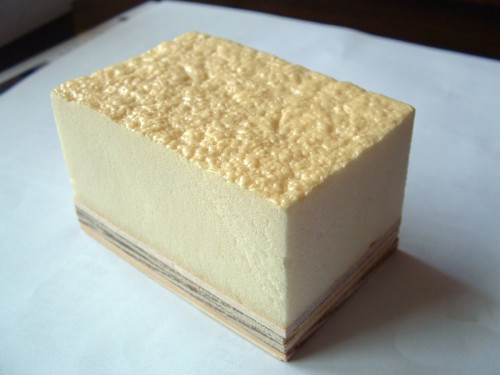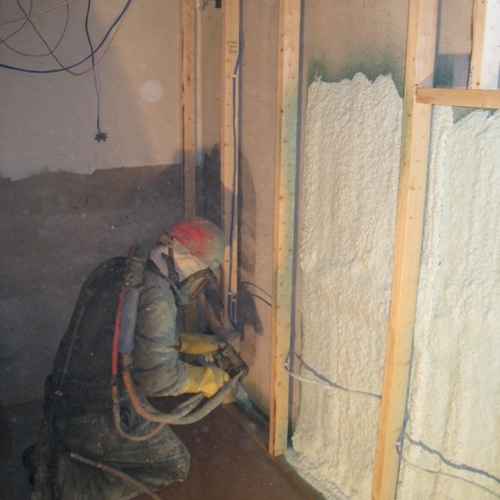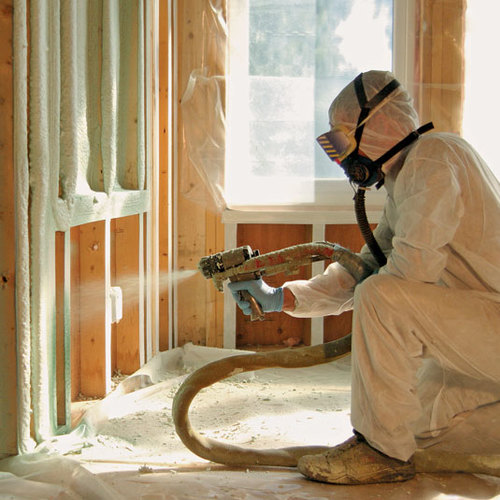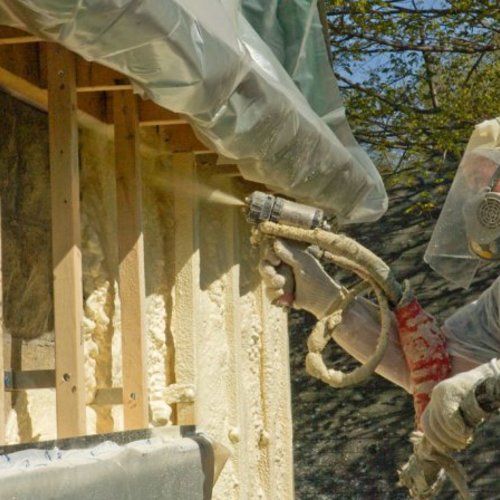
The Passive House Institute U.S. (PHIUS) has banned the use of spray polyurethane foam (SPF) with high global warming potential (GWP). The discussion on high GWP insulation was elevated in an excellent piece, “Avoiding the Global Warming Impact of Insulation,” written by Alex Wilson, the executive editor of Environmental Building News.
During Passivhaus training last year, it was stated that this could potentially be coming down the pipeline – so we weren’t surprised to see this pending regulation.
In the article, Katrin Klingenberg, the executive director of PHIUS, stated, “It does not make any sense at all to use them if one of the major overarching goals of energy conservation in buildings is to counteract and decrease global warming and climate change. There really is no point to go through all the trouble of detailed Passive House design calculations if you use high-GWP [global warming potential] spray foam.”
Weekly Newsletter
Get building science and energy efficiency advice, plus special offers, in your inbox.
A little off-putting
While we completely agree conceptually – there does seem to be something off-putting about banning certain products in a performance metric – especially as the SPF industry is taking steps to lessen the environmental impact of their products. Another EBN article, “New Chemical to Reduce Climate Impact of Foam Insulation,” stated that low-GWP blowing agents were almost market-ready and could be seen in the next 18 months.
One of the things we really like about Passivhaus is that it isn’t green by checklist – that it’s not prescriptive – but really open-ended and up to the designers to figure out the best approach for them to achieve substantial reductions in energy and CO2 emissions.
A slippery slope
If you are wondering why we think this precedent could slow industry adoption, the article goes on to discuss issues of embodied carbon and embodied energy of building materials. Said Katrin, “in the future I would like to add the embodied energy to those balances because of the significance in super-insulation.” And again, we definitely agree designers should take this into account and several (including ourselves, where possible) already do. For many, issues of GWP/ODP/PEI are intricately linked and all should be taken into consideration.
This precedent seems to be a bit of a slippery slope – where should the line be drawn? Who demarcates it? Should XPS and EPS be banned? Should concrete, which isn’t the most environmentally-friendly industrial process, be the next to be axed? Should all wood be FSC certified? What about houses that use granite countertops? Should rural and suburban projects be banned from certification? What about buildings that exceed a planned occupancy of greater than 50m² per person? It is an extremely delicate line, and the attractiveness for many (who were already doing BuiltGreen/LEED projects and incorporating earth-friendlier products) has been the simplicity that has allowed for the somewhat rapid adoption – especially for businesses or industries that can be a bit notorious to resist change.
According to the article, the new SPF rules will be in full effect by January of 2012. Regardless, we will continue to be fierce advocates and infamous cheerleaders for a regional Passivhaus movement that will have a meaningful impact.
Mike Eliason is a designer and certified Passivhaus Consultant at the Brute Force Collaborative in Seattle.















24 Comments
I so agree...
One of the many reasons a lot of Designers, Architects, Builders and Consumers get put off to many programs is that they becomes ARROGANT and IGNORANT of many other products and techniques that are as harmful, but for the lack of alternatives are hard to do without. As you said, the foam industry is working on reducing CO2 emissions, and there is the argument that spray foams reduce air infiltration like no other type of insulation. Should we look at the GWP of every product and limit to a few choices? Where should we build homes? Should we pre-determine a few styles and sizes of homes? Should we ban people from living rural? Should we all live in high-rise chicken coops like China? Should we all have one type of HVAC or plumbing system?
Wait a second...
Armondo,
With all due respect... you realize that Passive House, LEED for Homes, NGBS, etc, are OPTIONAL programs right?
Should we "ban people from living rural?" No, but awarding people who live that way with a green building/energy efficiency certificate doesn't make sense.
Consideration of GWP of building products is a good idea. Filling homes with petrochemical plastics is probably not the most "sustainable" building approach.
I agree that PHIUS, and
I agree that PHIUS, and others, is voluntary and that’s a good point, however, why should they band spray foam insulation only; (for the record, I spec mostly cellulose). Should next be SIPs, ICFs, and most important, rigid foam for outsulation, thermal bridging and condensation mitigation? there is hardly no difference in GWP with most rigid foams.
Most house sealers are made of petrochemicals, and the handful that are not, are not available in all markets. If we talk about double insulated walls and Larsen trusses, they have their issues of condensation as well; and there are many other products installed on houses just as bad.
Is the PHIUS going to regulate many other products consumers bring after moving in? Is it about one-upmanship to the PHI? Or other programs as well?
Slow down a bit...
Armando,
You acknowledge the validity of the point that PH certification is voluntary.
PHIUS doesn't issue permits, they issue certificates.
Why then does it matter so much to you if "they" want to ban SPF in "their" program?
I see Armando's point
I am on the same page as Armando. Although I agree that a high GWP and Ozone depletion potential are indeed problems which need to be addressed, (on that note, I believe there needs to be a different system to rate the organic factor of high performance buildings, where banning these things is appropriate). I think that the label "green" entails two completely different animals: 1: non-toxic, biodegradable, organic, truly eco-friendly materials 2: energy efficient/ high performance materials. Although there is a relationship between the two, they do not necessarily go hand in hand. Passive Haus, I always thought, focused entirely on the efficiency of the building envelope and also the air quality of the building. This has nothing to do directly with how the materials used are manufactured. If they want to cross that line, then those rules should apply to ALL or NONE of the products out there for "green"/high performance building. If polyurethane based spray foam is to be zeroed in on, so should all products, such as Armando's examples, and what about good old PVC? I dare anyone to build a truly 100% PVC-free home.
The fact that these programs are optional has zero relevance to the issue being challenged here. Optional or mandatory, it makes no difference in determining the playing rules.
Make no mistake: I am not undermining the serious problem regarding the GWP and Ozone depletion potential in most product manufacturing methods. I agree that something needs to be done about it, but not this way. As I said, a rating system based not on the performance of the building, but rather on the organic-ness of it, needs to be instituted and to drive the market under a new, isolated pressure.
...
I don't understand.
Why can't PHIUS change if they want to?
Aren't they just risking their own "market share" of high performance home certifications?
Why does the optional nature of the program have zero relevance?
What are the "playing rules"?
PH standards have been called arbitrary.
If it matters, why not just create your own set of arbitrary high-performance standards, skip the certification process and do what you want?
The all encompassing standard already exists.
You all may be aware of the Living Building Challenge. Its currently the most rigorous set of performance based imperatives by which one can chose to build. I'll confess to having such a project under way. Net zero energy is one of the prerequisites, so its designed Passiv Haus to get us most of the way to net zero.
My point? Take a look at the LBC's Red List of materials, its quite strict, yet we can still design and build to PHIUS' standards, and far beyond without using Red List materials. A couple of years ago Katrin Klingenberg started off our passive house training sessions talking about about endangered species. This began to make me feel that she has her eye on the big picture of sustainability, because her thought process didn't begin and end within energy efficiency, despite her focus on it with PHIUS .
We have a long way to go to reach sustainability, even within the Living Building Challenge, which is ever evolving. Its the bar I have chosen jump over, and its not entirely easy. However, the fact that it, and PHIUS, and many other standards exists, need not step on anyone's toes. I don't imagine that the implication of the developers of very challenging building standards and their revisions is to antagonize anyone, or to dismiss their personal choices as inadequate, or even exclude them from participating. They are merely trying to evolve. As the standards evolve, so will the materials and their manufacturers. Its becoming more and more irrefutable that we have been building with some pretty nasty materials for quite some time, and we haven't even begun to dig into the persistent toxins issue in this thread. (Of course, that would get us into the defining green or sustainability argument)
Believe it or not, in my case, it is costing us the same or even less to adhere to the red list, for a variety of reasons.
Despite all of this, can I afford to do a passive house retrofit on my home? Not right now. Did I get started and will I continue to chip away at it? Certainly. Do I have enough passive solar to reach the PH standard? No. Do 80 percent of the homes in my area have enough passive solar to reach it? No, too many trees. Should we blame the inventors and revisers of PH standard because of that?
I feel that sometimes we get so excited about certification that we lose track of the bigger picture.I wanted to build like this 5 years ago, but it wasn't within my means. Ultimately, for me, it comes down to whether or not I can go to sleep at night knowing that I did the best I could within my means.
While a great product...
I attended a presentation yesterday on spray foam and it has some fantastic qualities. It is used to provide a vapor and air barrier - and sound barrier. The thermal qualities are amazing as well. And it is easy to apply generally speaking.
The Passive House focus includes energy reduction and but also global warming reduction. Passive House is still possible without spray foam. It takes skilled craftsmen with a high attention to detail. Spray foam allows our installers to continue to be sloppy. Passive House requires contractors to maintain higher levels of craftsmanship standards and even more so without spray foam.
Personally, I don't want a passive house certified but sloppily built house or office packed with spray foam because the builders ... and designers were lazy.
Billions of us now live in or
Billions of us now live in or near "waste streams.". Just take a vacation to anywhere outside the US and tour the outskirts of your tourist town. Never ever going to change in my lifetime.
Do what you desire each of us, and if you like the movement toward green like we all do, then keep on doing.
Personally, I love the idea of being fully free of utilities, property taxes and grocery stores at least for some part of my life. It may just be summers on my boat eating fresh garden veggies from the garden or swinging in a hammock beachside in Panama.
And lastly, tech items like sprayfoam will and always will improve toward being more planet friendly.
Response to AJ
AJ,
You seem to have a solid faith in technological improvement: "Tech items like sprayfoam will and always will improve toward being more planet friendly."
Hmmm -- there is plenty of evidence to the contrary. In the 1930s, there were three or four common types of insulation: seaweed, cellulose, sawdust, and straw bales. Now we have spray foam. Which is more planet-friendly?
Here in Vermont, water pipes used to be made out of drilled logs. Now we have PVC. Which is more planet-friendly?
I would say that most lifestyles 2000 years ago were more planet-friendly than most lifestyles in 2011. So I don't know where you get your optimism.
IAQ
I wonder if some part of the PHIUS motive isn't an unstated concern for air quality -- since that is a principle tenet of passivehaus design -- given the expanding number of problems that have come via poor installation ranging from persistent dead fish smells to health issues. The GWP of sprayfoam is easier to quantify so it may be a case of, in addition, erring on the side of caution.
If so, I applaud Karin et al. I came to GBA fully intent on using spray foam and have learned that it's not quite ready for prime time.
Big Picture
It's interesting how the blowing agents in SPF can lead to such a philisophical green building conversation. In the same line as Martin Holladay said above if we all wanted to live completely green we'd just go in the woods, live in a hole and get used to the cold. At some point we, the people the high minded green living community, may have to accept that a climate controlled living environment, like high speed transit, is inherently unnatural. A perfectly sustainable, perfectly healthy, perfectly comfortable, perfectly beautiful home may actually be in the same category as perpetual motion.
Not to say that I won't keep trying, of course I will, but one has got to understand there's probably always going to be some environmental sacrifices made directly proportional to how much more sophisticated we want our lives than all the other creatures on this earth.
Not sure what the answer is to building materials question
After listening to the Green Architects Lounge podcast a few months ago (can't remember which episode) Phil Kaplan and Chris Briley got into a brief sideline discussion about building materials with Phil making the comment that 'PVC is evil and should be avoided' because of the environmental damage due to the petroleum industry. "Great", methinks, but if we would replace all that PVC with wood, where appropriate? That would lead to much greater deforestation. Think of what that is doing to boreal forests in Canada or rain forests in the Amazon. "Not great", merethinks. Or what if we replaced it with steel, aluminum, copper and other metals, where appropriate? "Eeek", merethinks some more. That would lead to large increase in mining activity and think of the devastation from mining in Chile or the DRC. Masonry? No way. It's one of the most energy intensive materials there is.
So what's the answer? Bamboo, straw bale, adobe, 2-liter bottles? I don't know but I think much more consideration should be given to the question.
Affordability should also be a major consideration. Green building concepts should not be only a playground for the rich while poor and working people live in the waste streams.
Lots of issues, I know, and hard to draw distinct lines in the sand as PHIUS may appear to be doing, but these are critical issues if we are going to be serious about sustainability.
I applaud the efforts of the PHIUS.
http://inspirationgreen.com/plastic-bottle-homes.html
Airtightness durability of sprayfoam
Besides the GWP issues with spray foam, I would like to note that even though the R-value of spray foam is relatively high and thus makes it an ideal candidate for window installation, the airsealing properties of spray foam (both in windows and in walls assemblies) are not sufficiently durable to guarantee a good airtight connection between different construction materials bc it shrinks overtime - recommended way to do make a seal that has long term durability, without any IAQ/GWP issues, is with this Pro Clima tape, which I happen to import with http://www.foursevenfive.com.
This picture is of leaking sprayfoam (a month old) during a blowerdoor test at a doorframe. Eventhough it appeared to seal the entire frame (even oozing out), the foam still leaked. Tape, although taking somewhat longer to install does make a better seal - being sloppy won't work for either method!
Response to Todd Collins....Postcards from the trenches
Bravo to Skill and Standards Todd. As a environmental professional in Maine spray foam is helping to build my business. http://www.gotbadair.com As with any amazing product application is key. In fact it's such a amazing barrier I have several clients that now have homes full of moisture and structural rotting due to a choice of spray foam application, recommended by the energy efficiency company, in a wet crawlspace and basement. No effort was made by these spray foam companies to address the moisture issue in these homes. One crawlspace had the walls spray foamed with a closed cell product without addressing the poorly installed vapor barrier on the dirt floor with visible pooling water on top of the vapor barrier and significant moisture under. The mold counts were off the scale...lots of visible mold. Another wet basement with a perimeter drain had spray foam applied. There was no thought to possibly installing a perforated mat behind the foam to help with moisture and now the sill plate is rotting and 1st level floors are buckling. Also the thermal barrier they applied to the spray foam is cracking. And last but surely not least is my client who has become so ill from the mold and other still to be determined air quality issues in her home.....possible off gassing from a improper spray foam application....I had to mask up to do the inspection due to the overwhelming odor and respirtory problems I experience in her crawlspace....test results still out. These were all problems that were not caused by the same spray foam company but several. Ok one more....lets go to the top of the house with another client. The new spray foam application that seems to be the rage here in Maine with BPI and other energy efficiency companies is to spray foam the soffit area of the attic, my client believed that they were doing what was best for his attic. They told him no soffit vents but keep the ridge vent. I show up a couple years later. Attic covered with mold. I could go on and will be back....but for now I'm back to the trenches of poor skill and application. But thanks for the work.
On a side note....of the hundreds of homes I'm in a year the best air quality is in those 100 year old places with tar paper and barn boards.
Terry Piersion, what is your
Terry Piersion, what is your idea of a net zero home that would not need your services?
Martin, really? Give it a
Martin, really? Give it a break. Technology and capitalism in general are moving ahead as fast for solutions as they are for PROBLEMS. Why right here in Albany we are inventing nano scale technology that no one could imagine only a few short years ago.
I believe in the future and I believe in the good of what is being invented every day.
Your glass is empty, mine us brimming full.
aj builder ...Postcards from the trenches
What net zero home would never need my services? The answer is clear as there are so many intelligent people involved in finding these answers. Strategies to bring indoor air quality to the highest standard possible include using mold and moisture prevention strategies, well insulated building shells, active solar, low/no VOC finishes and fresh air circulation and filtration. The problem is the execution of these ideas and the trickle down effect of great ideas that become poor applications. I'm not sure the air tight/energy efficient industry is always the best for the air quality in a home without follow through of good ideas. I see those trickle down effects all the time here in the trenches....and leave my business card.
All our cups runneth over...
AJ,
Your faith is unassailable.
Spray Foam-Non Ban
This is a really good post and Mike makes good points -- the only problem is that it's ground that PHIUS covered with Mike several weeks ago. And at that time, we made clear that because these are good points, PHIUS is revisiting this subject and referring it to its technical committee for review. That recently-formed committee includes Passive House-savvy representatives from around the country, including the the Northwest--to ensure regional concerns are a part of the concern.
Also, for the record, we're not talking about spray foam, we're talking about a specific blowing agent. And this is a non-issue in Europe, as it's been legally banned by the government.
Michael Knezovich
Pasive House Institute US
What is Pure
My interpretation of this post is that Passivhaus' success is derived from its pure capacity to meet a very specific energy and comfort goal. That lends itself to marketability and client buy in, which no other standard can meet. While I cannot see this specific ban causing too much trouble for new construction, it does raise the question what could be next? The ban seems not to have context within how Passive House is being developed in the US. Is GWP a new policy goal for the newly freed PHIUS? Is PHIUS now back peddling because there is no stated goal?
On a practical note I disagree with the ban as it will limit design options for aspects of projects that may only be viable with spray foam. When we talk retrofit this ban will certainly be a deal breaker for many potential clients. What is the GWP of doing much less EE on existing buildings? I think a better way is to incorporate total GWP in the PHPP rather than redlining options.
missing something?
M Knezovich said:
"Also, for the record, we're not talking about spray foam, we're talking about a specific blowing agent. And this is a non-issue in Europe, as it's been legally banned by the government."
Not too sure about the tone or logic of this statement. I get the HCFC problem, but does the fact that chemistry presents a GWP issue somehow mean that sprayfoam is NOT in fact unacceptable to PHIUS? And does the lack of government leadership in the US years ago (or whatever timeline is needed to get a different blowing agent into the product for consumers) somehow mean that the government is to blame for either the GWP or the ban?
The world would be different if it was a different world .... sounds like an offshoot of monkey math rather than clarification. If I'm missing something out of ignorance, apologies in advance.
Cost of closed cell spray foam insulation
I work for an agency and have sent contractors and staff for Federally subsidized training to install spray foam insulation. I know that the cost of closed cell spray foam was up to about $4.50.sq.ft. two years ago. With the collapse of the housing market I have seen quotes that have reduced the cost to $2,65/sq.ft. I just had a quote to spray foam closed cell insulation in the joists of a walk up attic and the quote was close to $11,000.00 and they refused to break it down by sq.ft. What is the going rate in Hull, MA 02045? With the gov. subsidy and the prevailing rate at $14.00/hr I cannot afford to overpay. Somebody help me out.
Spray Foam - inert or not inert?
Lately there is a lot of speculation that spray foam insulation is not as inert as once thought and in fact, SPF may continue to off gas for many years. The EPA has also voiced their concern about the need for further research on the short and long term safety of SPF in residential use.
We are in contact with 30 other families in the USA and Canada who may be suffering from symptoms related to their SPF home (NOTE: schools and offices are using it too).
Some families have moved out of their homes. Other families have removed roof decks and/or walls of SPF in hopes of reducing the chemicals and symptoms experienced in the home. Some families have no choice other than to remain in their home and rely on mechanical ventilation/filtration to help ease the chemical burden and symptoms, but find little relief.
After nearly a year of research, ventilation, lots of lab testing (chamber and air samples), and expert opinions, our family has begun tedious process of removing our SPF (roof deck and wall cavities). The removal is being performed by a local remediation company (the company has removed SPF in homes prior because of mold and moisture issues.
A detailed protocol created by our Certified Industrial Hygienist (other credentials include CSE, CIEC, CEICC, CIAQP, CIAQC) whom has experience (20+ yrs.) with isocyanates (Side A of the two part foam) is being followed to ensure safe removal (dust created from breaking the foam is a respiratory and dermal hazard).
We are hopeful that removal of the SPF along with soda blasting will remove and neutralize the chemicals associated with the application of the SPF. We will do more testing after remediation is complete to ensure a safe environment prior to resuming to build
According to the EPA the SPF should be cured (inert) and safe for re-entry 23-72 hrs after install. According to SPF companies, there should be no odor or off gassing after it is cured.
Our home experienced something much different; a chemical smell has lingered and when we entered the home we experienced respiratory issues, headache, flu aches, muscle aches, throat, eye irritation and chest pain. On warm days, the smell and symptoms were more severe. Some visitors experienced the same symptoms while others do not. There is a varying degree of threshold levels, but almost everyone, after prolonged periods complain of eye, throat irritation.
A lot of lab work has been completed by a well known leader in product testing. Our chamber and air tests show a long list of chemicals that at even low levels, chronic exposure to most of the captured chemicals in our home will undoubtedly cause health issues after little or prolonged exposure. Frighteningly, our chemical profile from both the chamber and air testing mimics most of the other homes experiencing the same complaints with the SPF.
Is this all a coincidence that the same chemicals are found in homes with spray foam and the owners are experiencing the same symptoms?
Today we are much more sensitive to things that contain isocyanates and flame retardants. Renting a car, walking into REI, IKEA, and HomeDepot can cause eye irritation, burning throat and chest congestion. Even running on a refinished track or wearing a wetsuit can evoke our symptoms.
Other SPF homeowners have had severe reactions and illness thought to be associated with the chemicals from the SPF. Children of some of these SPF homes develop a chronic cough and asthma like breathing. Chronic low grade fever and autoimmune responses have also been observed. Muscle aches and mental confusion and chest pain are other symptoms and can be seen during exposure and/or develop after being in an SPF home for long periods.
Our SPF manufacturer/supplier is very aware of our complaints and concerns (and the complaints of the other homeowners), but the company continues to deny any sort of problem with their product.
The contractor who installed the foam (in18 degree weather, with zero ventilation during install [two weeks], and allowed us and others to be in the home during installation) denies anything is wrong. Needless to say, like most of the other homeowners, we are left on our own to handle this because the science is not yet 'there'.
Do you have SPF insulation somewhere in your home (attic, wall cavities, crawl space)? Do you experience asthma like symptoms, chronic cough, headache, throat or eye irritation, nausea, skin rash, muscle aches, flu-ish, any new autoimmune issues since moving into or installing SPF?
If so, do your symptoms decrease when away from the home OR during times of lower temperatures?
Another issue has been seen in older SPF in homes. Have you had SPF insulation for 1-8 years and recently notice a new chemical odor or the above symptoms? A family we know has removed SPF from their home after 6 yrs. because in June 2011 it started to smell and the family had to move out because of their related symptoms. Test results indicate the foam is decomposing and releasing the same chemicals that we have in our relatively newly sprayed home.
I hope our situation is a random, but if it is not and other homeowners with SPF are experiencing similar symptoms, it is important that information is being gathered and awareness is spread.
Log in or create an account to post a comment.
Sign up Log in